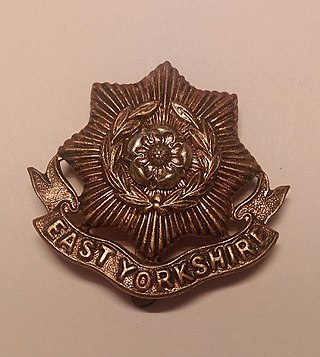
The 31st Division was an infantry division of the British Army. It was raised in the Great War by volunteers from Kitchener's Army and formed in April 1915 as part of the K4 Army Group and taken over by the War Office on 10 August 1915. Comprising mainly infantry battalions from Yorkshire and Lancashire, the division was sent to Egypt in December 1915 before moving to France in March 1916 and spent the remainder of the First World War in action on the Western Front. The 31st Division was the quintessential New Army division, being made up entirely of Pals battalions.

The 32nd Division was an infantry division of the British Army that was raised in 1914, during the First World War. The division was raised from volunteers for Lord Kitchener's New Armies, made up of infantry 'Pals battalions' and artillery brigades raised by public subscription or private patronage. The division was taken over by the War Office in September 1915. It served in France and Belgium in the trenches of the Western Front for the duration of the war. It saw action at the Battle of the Somme, the Pursuit to the Hindenburg Line, the Defence of Nieuport, the German spring offensive, and the Allied Hundred Days Offensive beginning at the Battle of Amiens. After the Armistice it marched into Germany as part of the Army of Occupation.
The 102nd Brigade was an infantry formation of the British Army during World War I. It was raised as part of 'Kitchener's Army' and assigned to the 34th Division. After the original formation was converted into a reserve brigade, the number was transferred to a brigade of 'Tyneside Scottish', four 'Pals battalions' of the Northumberland Fusiliers recruited from men of (mainly) Scottish birth or heritage working on Tyneside. The brigade landed in France at the end of 1915 and then served on the Western Front for the rest of the war. The brigade suffered appalling casualties on the First day of the Battle of the Somme. It recovered to participate in the Battle of Arras in 1917, but was virtually destroyed during the German spring offensive of 1918. It was reconstituted with different units in time to take part in the final battles of the war and the post-war occupation of the Rhineland.

The Accrington Pals, officially the 11th (Service) Battalion (Accrington), East Lancashire Regiment, was a pals battalion of Kitchener's Army raised in and around the town of Accrington during the First World War.
The Sheffield City Battalion was a 'Pals battalion' formed as part of 'Kitchener's Army' during World War I. Raised by local initiative in the City of Sheffield, it became the 12th (Service) Battalion of the local York and Lancaster Regiment. After almost two years of training, it was virtually destroyed on the first day of the Battle of the Somme in a disastrous attack on the village of Serre. The battalion continued to serve on the Western Front, including the Arras offensive, but it was disbanded early in 1918.

The Barnsley Pals were two 'Pals battalions' formed as part of 'Kitchener's Army' during World War I. Raised by local initiative in the town of Barnsley in the West Riding of Yorkshire and recruited largely from coalminers, they became the 13th and 14th (Service) Battalions of the local York and Lancaster Regiment. After almost two years of training, the battalions suffered heavy casualties in a disastrous attack on the village of Serre on the first day of the Battle of the Somme. They continued to serve on the Western Front, including the Battle of Arras (1917). Combined into a single battalion in early in 1918, the Barnsley Pals were reduced to a remnant during the German spring offensive, but the battalion was rebuilt to participate in the final victorious Hundred Days Offensive.
The 89th Brigade was an infantry formation of the British Army during World War I. It was raised as part of 'Kitchener's Army' and was assigned to the 30th Division. After the original formation was converted into a reserve brigade, the number was transferred to the Earl of Derby's brigade of 'Liverpool Pals'. The brigade landed in France at the end of 1915 and then served on the Western Front for the rest of the war, seeing action at the Somme, Arras, and Ypres. Virtually destroyed during the German spring offensive of 1918, it was reconstituted in time to take part in the final battles of the war.
The 90th Brigade was an infantry formation of the British Army during World War I. It was raised as part of 'Kitchener's Army' and was assigned to the 30th Division. After the original formation was converted into a reserve brigade, the number was transferred to a brigade of 'Manchester Pals'. The brigade landed in France at the end of 1915 and then served on the Western Front for the rest of the war, seeing action at the Somme, Arras, and Ypres. Virtually destroyed during the German spring offensive of 1918, it was reconstituted in time to take part in the final battles of the war.
The 91st Brigade was an infantry formation of the British Army during World War I. It was raised as part of 'Kitchener's Army' and was assigned to the 30th Division. After the original formation was converted into a reserve brigade, the number was transferred to a brigade of 'Manchester Pals'. The brigade landed in France at the end of 1915 and was transferred to the Regular 7th Division. It saw action at the Somme, Arras, and Ypres before being sent to the Italian Front, where it took part in the final Battle of Vittorio Veneto. The brigade's number was briefly revived during the 1950s.
The 92nd Brigade was an infantry formation of the British Army during World War I. It was raised as part of 'Kitchener's Army' and was assigned to the 31st Division. After the original formation was converted into a reserve brigade, the number was transferred to a brigade composed volunteer battalions raised in the city of Kingston upon Hull for 'Kitchener's Army'. It first served in Egypt defending the Suez Canal between January and March 1916. It then left for the Western Front where it was at Serre on the first day of the Battle of the Somme in 1916, though its battalions escaped the worst of the disaster. It continued to serve on the Western Front for the rest of the war, including hard fighting at Oppy Wood, against the German spring offensive and in the final Hundred Days Offensive.
The 93rd Brigade was an infantry formation of the British Army during World War I. It was raised as part of 'Kitchener's Army' and was assigned to the 31st Division. After the original formation was converted into a reserve brigade, the number was transferred to a brigade of 'Pals battalions' from Northern England. The brigade was sent to Egypt at the end of 1915 but was recalled to France shortly afterwards and then served on the Western Front for the rest of the war. The brigade was shattered on the First day on the Somme, but later saw action at Arras, in the German spring offensive of 1918, and the final Hundred Days Offensive.
The 101st Brigade was an infantry formation of the British Army during World War I. It was raised as part of 'Kitchener's Army' and was assigned to the 34th Division. After the original formation was converted into a reserve brigade, the number was transferred to a brigade of 'Pals battalions'. The brigade landed in France with 34th Division at the end of 1915 and then served on the Western Front for the rest of the war, seeing action at the Somme – when its battalions were shattered on the First Day – and at Arras and Ypres. Virtually destroyed during the German spring offensive of 1918, the brigade was reconstituted with new units in time to take part in the final battles of the war.

98th Brigade was an infantry formation of the British Army created to command 'Kitchener's Army' units during World War I. It served on the Western Front from 1916, seeing action on the Somme, at Arras and Ypres, during the German spring offensive and the final Allied Hundred Days Offensive.

The Capture of Oppy Wood was an engagement on the Western Front during the First World War on 28 June 1917. The Battle of Arras of 1917 ended with the Germans in possession of a fortified wood to the west of the village of Oppy, which overlooked British positions. The wood was 1 acre (0.4 ha) in area and contained many German observation posts, machine-gun nests and trench mortars. New German defensive tactics adopted after the Battle of the Somme of defence in depth and rapid counter-attack, had been enforced on the German 6th Army after the disaster of 9 April, the first day of the Battle of Arras. The British attack of the Third Battle of the Scarpe (3–4 May), was defeated everywhere bar Fresnoy, which was captured by the 1st Canadian Division. The attack on Oppy Wood by the 92nd Brigade of the 31st Division, was a costly failure. The area was defended by the 1st Guard Reserve Division and the 15th Reserve Division, which did not need the support of specialist Eingreif (counter-attack) divisions.
The 4th Guards Brigade was an infantry formation of the British Army during World War I. It was formed from battalions withdrawn from the Guards Division and served with the 31st Division on the Western Front during the last year of the war. It fought during the German spring offensive, distinguishing itself at the Defence of Nieppe Forest. Taken out of the line after its heavy casualties, the brigade spent the last months of the war as General Headquarters Troops, including a period as a motorised column, before being broken up in the Guards Division after the Armistice.

The Hull Pals were a brigade of four battalions of the East Yorkshire Regiment raised as part of Kitchener's Army in 1914. They served in 31st Division at Serre on the first day of the Battle of the Somme in 1916, though they escaped the worst of the disaster. However, they suffered heavy casualties in the same area later in the year, and again at Oppy Wood in early 1917. They continued to serve on the Western Front for the rest of the war, including hard fighting against the German spring offensive and in the final Hundred Days Offensive.
The 6th Battalion, Cheshire Regiment was a Territorial Force (TF) unit of the British Army. Formed in 1908 from Volunteer units recruited in Cheshire since 1859, it was one of the first TF units to go to the Western Front in World War I. It had a wandering existence, moving frequently from one command to another, seeing a considerable amount of combat at the Somme, Ypres, during the German spring offensive and in the final Allied Hundred Days Offensive. After the war it was amalgamated into a local artillery regiment.

The 33rd Divisional Artillery, popularly known as the Camberwell Gun Brigade, was a Royal Artillery force raised as part of 'Kitchener's Army' in early 1915. Recruited in the Borough of Camberwell, South London, the units served with the 'Pals battalions' of the 33rd Division on the Western Front for three years. They also supported other formations when 33rd Division was out of the line. The batteries saw action at the Somme, Arras, and Ypres, suffering heavy casualties. They were particularly distinguished defending against the German spring offensive of 1918, and continued through the victorious Allied Hundred Days Offensive.

The 32nd Divisional Artillery was a Royal Artillery force raised as part of 'Kitchener's Army' in early 1915. Recruited in Yorkshire, originally for the 31st Division, the units served with the 'Pals battalions' of the 32nd Division on the Western Front for three years. They saw action at the Somme, the pursuit to the Hindenburg Line, the German spring offensive, and the Allied Hundred Days Offensive.
The 12th (Service) Battalion, Manchester Regiment, was a unit of 'Kitchener's Army' formed immediately after the outbreak of the First World War. It saw action in the Ypres Salient in 1915–16, on the Somme in 1916, including actions at Mametz Wood and the Battle of Delville Wood, and in the Arras Offensive. It was then amalgamated with the dismounted cavalry of the Manchester-based Duke of Lancaster's Own Yeomanry (DLOY) to become the 12th (DLOY) Battalion, Manchester Regiment. It continued serving on the Western Front until the Armistice with Germany, including the Battle of Passchendaele, the German Spring Offensive and the final Allied Hundred Days Offensive.













